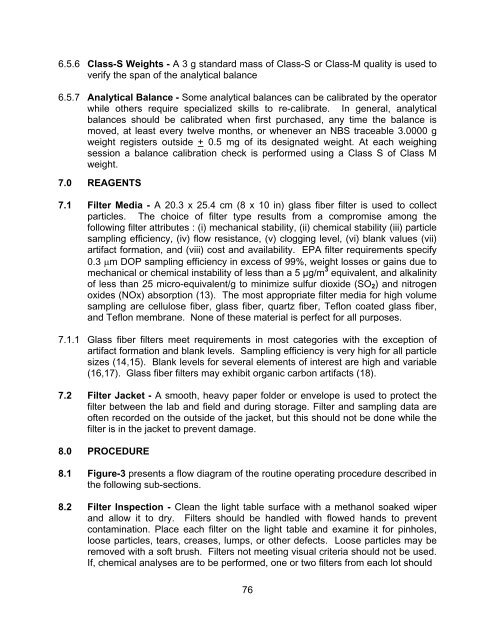Ambient Air quality Monitoring Guidlines. - Maharashtra Pollution ...
Ambient Air quality Monitoring Guidlines. - Maharashtra Pollution ...
Ambient Air quality Monitoring Guidlines. - Maharashtra Pollution ...
You also want an ePaper? Increase the reach of your titles
YUMPU automatically turns print PDFs into web optimized ePapers that Google loves.
6.5.6 Class-S Weights - A 3 g standard mass of Class-S or Class-M <strong>quality</strong> is used to<br />
verify the span of the analytical balance<br />
6.5.7 Analytical Balance - Some analytical balances can be calibrated by the operator<br />
while others require specialized skills to re-calibrate. In general, analytical<br />
balances should be calibrated when first purchased, any time the balance is<br />
moved, at least every twelve months, or whenever an NBS traceable 3.0000 g<br />
weight registers outside + 0.5 mg of its designated weight. At each weighing<br />
session a balance calibration check is performed using a Class S of Class M<br />
weight.<br />
7.0 REAGENTS<br />
7.1 Filter Media - A 20.3 x 25.4 cm (8 x 10 in) glass fiber filter is used to collect<br />
particles. The choice of filter type results from a compromise among the<br />
following filter attributes : (i) mechanical stability, (ii) chemical stability (iii) particle<br />
sampling efficiency, (iv) flow resistance, (v) clogging level, (vi) blank values (vii)<br />
artifact formation, and (viii) cost and availability. EPA filter requirements specify<br />
0.3 µm DOP sampling efficiency in excess of 99%, weight losses or gains due to<br />
mechanical or chemical instability of less than a 5 µg/m 3 equivalent, and alkalinity<br />
of less than 25 micro-equivalent/g to minimize sulfur dioxide (SO2) and nitrogen<br />
oxides (NOx) absorption (13). The most appropriate filter media for high volume<br />
sampling are cellulose fiber, glass fiber, quartz fiber, Teflon coated glass fiber,<br />
and Teflon membrane. None of these material is perfect for all purposes.<br />
7.1.1 Glass fiber filters meet requirements in most categories with the exception of<br />
artifact formation and blank levels. Sampling efficiency is very high for all particle<br />
sizes (14,15). Blank levels for several elements of interest are high and variable<br />
(16,17). Glass fiber filters may exhibit organic carbon artifacts (18).<br />
7.2 Filter Jacket - A smooth, heavy paper folder or envelope is used to protect the<br />
filter between the lab and field and during storage. Filter and sampling data are<br />
often recorded on the outside of the jacket, but this should not be done while the<br />
filter is in the jacket to prevent damage.<br />
8.0 PROCEDURE<br />
8.1 Figure-3 presents a flow diagram of the routine operating procedure described in<br />
the following sub-sections.<br />
8.2 Filter Inspection - Clean the light table surface with a methanol soaked wiper<br />
and allow it to dry. Filters should be handled with flowed hands to prevent<br />
contamination. Place each filter on the light table and examine it for pinholes,<br />
loose particles, tears, creases, lumps, or other defects. Loose particles may be<br />
removed with a soft brush. Filters not meeting visual criteria should not be used.<br />
If, chemical analyses are to be performed, one or two filters from each lot should<br />
76
















